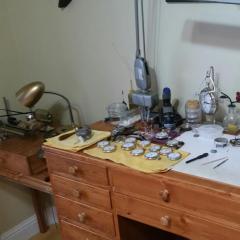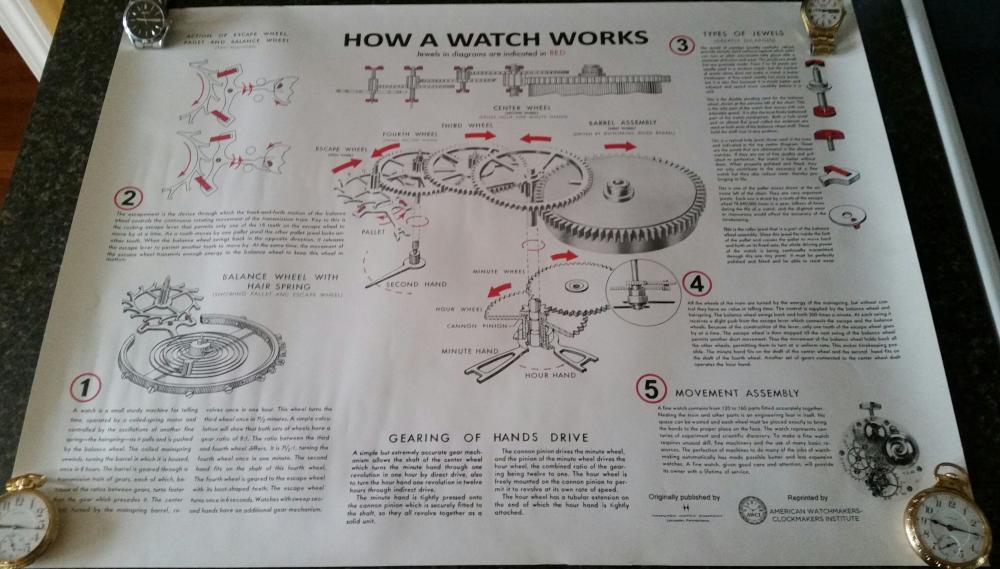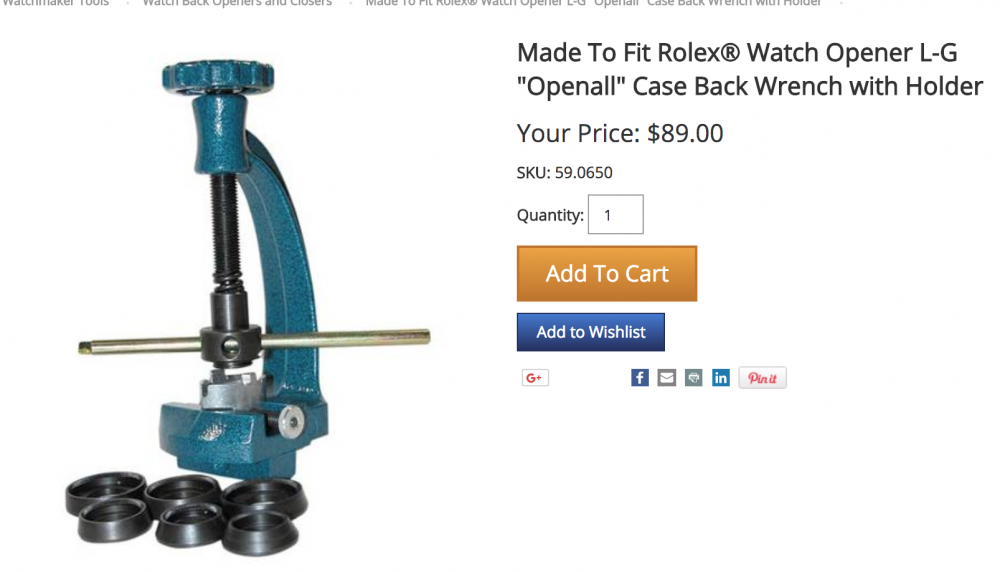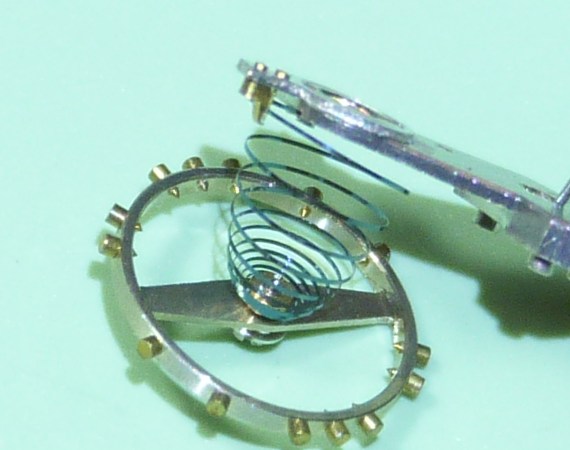Leaderboard
Popular Content
Showing content with the highest reputation on 04/10/18 in all areas
-
I just received my copy of the "How a watch works" poster, originally produced by the Hamilton watch company. It's now being reprinted by the American Watchmakers-Clockmakers Institute. They have two sizes available, 18x24 and 24x36. This is the smaller one, and will get framed and go in my watch room!3 points
-
You used the car analogy. Starting with a badly damaged Rolex is like doing a rebuild of a BMW V12 instead of a clutch change on a Mondeo. No reason why you can’t do it, it’s just a serious case of jumping in at the deep end. Sent from my iPhone using Tapatalk3 points
-
Hello and welcome to the forum! You have a nice watch, and the guys here are experienced and know what they're talking about regarding watch repair even if it sounds a bit hard-edged. The good thing is that working on a quality watch such as rolex is easier than working on a cheap watch....IF you've formed a good foundation on the basics of horology. There are so many things that go into watch repair, but let me start with just opening the caseback. You'll need a special rolex-type opener: You see how much this is? That's just the beginning! You'll need a set of quality tweezers, screwdrivers, movement holder, eye magnification, dial protector, parts bin, and a benchtop mat with good lighting just to get the movement out and ready to disassemble. Cleaning will require sonification detergent, or non-residue solvent such as naptha to clean the movement. Rust will require special treatment or replacement of parts ($$$). We will assume you have a camera to take pictures along the tear down process way or you'll never be able to put it back together. Once cleaned you'll need specific oils (at least 5 types)/grease and a few other things. I would suggest you put that Rolex aside for now, and start with a large pocket watch or a cheap movement (working) that you can practice on...work on handling the small screws, levers, springs and plates to get an idea of how long you'll need to practice before attempting the Rolex. For me, it took at least one year before I could actually take apart a watch and put it back together in working condition, and another year before I could diagnose simple problems, fix them and get the watch running. another 6 months before I learned how to actually regulate a watch using a timegrapher. I did my first Rolex (bunch of bulova, walthams, omegas and cheap pin levers first!) with 2 years 8 months under my belt. J2 points
-
2 points
-
I was just given sound advice. Watch repair is a skill that takes many years to acquire. Also a Rolex is not for the faint hearted. All Rolex parts are not only extremely expensive they are very hard to source. If your watch has had water ingress the movement parts are highly likely to be rusted and they will need replacing. By the time you have added the cost of parts & dial re-furb it won't be far short of purchasing a replacement watch IMO.2 points
-
OK, some success. I decided to try my hand at smoothing out the distortion at the terminal end of the hairspring. After the initial attempt, the readings were as follows: Rate: -541 s/d Beat error: 0.5 ms Amplitude: 174 deg BPH: 18000 Big improvement over the previous readings so the next step was to adjust the rate. Not sure how I did it but the hairspring got dislodged from the regulator pins. The regulator has a lip at the bottom (see photo) which means I would have to twist the hairspring to get it back in. Is this acceptable or is it best to disconnect the hairspring at the stud?1 point
-
They are not for left and right, they are for different size spring sizes at the arbour. Sent from my iPhone using Tapatalk Pro1 point
-
1 point
-
1 point
-
When reassembling there are a few checks you can make as you go ! After assembly of the wheel train and spring barrel I give it a LITTLE wind and look at the 4th wheel and escape wheel for run back they should stop and run back a little bit due to the inertia in the train causing backlash in the mainspring. No run back something binding like the spring barrel cover not seated correctly as has already been mentioned. I then oil barrel and train if all's well the run back will increase. I then mount the balance wheel ( without the pallet installed.) I then check for end shake freedom of rotation ,hair spring orientation laterally and contricity and the position of the impulse pin it should be on a direct line with centre off the balance staff and the escape wheel staff. Take balance wheel and bridge out again and install pallet give one wind of crown the pallet arm should be on one banking pin I then take my fine tweezers put them together and push slowly on the fork end in the direction it travels when It gets almost half way it should jump across to the other banking pin do the same thing the other way and it should jump back. That took longer to type than it takes to do.1 point
-
Welcome! I'll echo a lot of the advice already posted here: You have quite a bit to learn before getting to that rolex, provided it's even salvageable. Get some tools (don't cheap out on the basics), a few dirt cheap movements on ebay, and practice. May I suggest you start with a pocket watch (parts are bigger), and then move down to wristwatches once you're a bit more comfortable. Also, break a cheap movement and you're only out a few dollars; break a rolex hairspring, and you may be a out many hundreds of dollars (yes, MANY hundredS)... Rust will destroy watch parts in not time if they stay exposed to moisture; watch parts are not very big and it's easy for rust to eat up all the material that's there, and you're left with a blob of rust dust... My guess is that the price you were quoted is so high because most of the parts of the movement need to be replaced... and that probably doesn't include the dial. If the damage is bad, there is potentially thousands of dollars worth of parts that will need to be replaced (assuming you want genuine)... Let us know how you do and post pictures when you get it open, it may not be bad.1 point
-
I have many of these and my video on youtube shows how to use it. Sent from my iPhone using Tapatalk Pro1 point
-
There again you're confusing the OP and leading the topic off way with your talk of magnetization first, then insinuating that the timing application is lying, and now suggesting that something is wrong with the hairspring length! All that when it was clear since the beginning that the watch suffers of poor amplitude! Each one had the right to speak his thinking here, but I will have to tell frankly now that your postings on this topic have been wrong and useless. And as moderator I must apologize for the unusually low quality of this thread.1 point
-
Hi Hidavidd. It is probably more economical to sell the watch and buy a used one. But that is not why you are here is it! One of the first watches I worked on was a gold 50s Rolex I bought for my girlfriend, it had a chipped dial. I managed to get the movement out in one piece, carefully touched up the dial with tipex, and gave it to her. It ran like that and was used intermittently as a dress watch for years. She had so much fun out of it, never being 100% sure it was "real", until a jeweler confirmed to her it was real, and still not worth much! I would be inclined to just fix it up, keep the dial and hands more or less as is, after some straightening. I think you need to start with some broken watches, take them apart, read Donald De Carl's books. Might take you a couple of years to get up to speed. I am please you haven't just hacked the back off. Maybe put that to one side for a while. Perhaps you can open the back for a look using a squash ball, just make sure you don't bend the hands if the crystal is missing. I wouldn't do much more though than look inside right now!1 point
-
Are any of these useful. https://www.ebay.co.uk/itm/Big-Lot-with-Antique-Vintage-Pocket-Watch-crowns-Watchmakers-Watch-Parts/352326262825?hash=item5208482029:g:h0oAAOSw-qVay~441 point
-
Without any watch repair experience & correct tools you will not be able to repair it yourself. The dial face will have to be repaired by a dial repair specialist. The movement will have to be serviced and repaired by a competent horologist.1 point
-
Your watch has the Incabloc balance jewels video below shows how it works. Video isn't 100% correct in that the hole jewel is permanently mounted in the setting. But the Cap jewel is supposed to come off for lubrication. Then notice how the Cap jewel is flat on one side curve on the other. It's a common mistake that people put the wrong side out. Then the settings themselves and or the Cap jewel is usually a different size or thickness on the dial side. https://www.youtube.com/watch?v=FakIAZxcDII If it takes more winding of the crown to get the balance wheel turning it's an indication of friction someplace.1 point
-
1 point
-
Wasn't aware I was suggesting chasing ghosts. Looking at the known readings I can't see reference to + or - 75 or 612 respectively. Considering it's an old movement, minus 75 initially then moving to minus 612 after servicing would make more sense to me. Most old movements, neglected, dirty, with no lubrication, usually run very slow but normally don't even run. Applying too much oil can make a slow movement run even worse. Does the app used give a + or - ? ? If it is fact running + then a slightly spiral hairspring or a touching hairspring may well be the cause. But once again with readings as shown I personally wouldn't do anything without a practical test run of the watch. Ok it might be a bit obsessive but I demagetise before, during and after servicing. It's never my intention to de-rail a thread ? Sent from my SM-G920F using Tapatalk1 point
-
Hi I am very interested in watch repair as a hobby. I find the videos fascinating, almost cathartic. I look forward to learning from the skilled people here.1 point
-
Hello, I'm a watchmaker from Glasgow, I found my way onto WRT through a google image search for an obscure machine! Looks like a great forum, I'm looking forward to getting stuck in. Cheers, Lewis1 point
-
My advice is buy another watch to use, and put that one to one side for now. Get Donald De Carle's book Practical Watch Repairing, and some old watches for £1 or so each, and try taking them apart after reading the first bit of the book. It's quite funny. Friends see the book, a few screwdrivers, hammers etc, and watches in pieces, and immediately start offering you their family heirlooms to repair, saying they don't trust the high street expert! lol.1 point
-
Very importance in watch repair is not to do something until you know why you're doing it. The watch magically changed between the before and after.. Pocket watches a little bit different in that we've had 100 years of watch repair and all sorts of bizarre things have happened then occasionally lengthening the hairspring can be a solution. In other words it started with a fast problem it didn't occur in between like we have here. It's unlikely the hairspring magically shortened itself at the stud. So re-pinning at the stud isn't an option for this watch besides this is a modern watch there probably is no hairspring left over at the stud.. So a challenge and watch repair is grasping what you're looking at or wait your looking for. Often times people grab microscopes thinking because it's really be egg the problem will jump out and wave at them and it doesn't. True magnification helps but you still have to grasp what you're looking at. So one of the things you did good for us in the discussion is you did a before. It's always nice to know where you started from. So the before it looks quite nice and you should have been able to regulate out it's running fast. The reason I bring this up is a lot of the problems that could cause what were seeing wouldn't have occurred in normal cleaning. So the easiest thing is to destroy damage as a beginner are screwing up to hairspring. If you try really hard sometimes not very hard even been the pivots or worst-case break them off. Breaking off 10 speak quite common for all of us from time to time. So read the post by Siro Particularly beginning. But the balance wheel removed to the pallet fork removed you gently start to wind the watch the trains spins stop winding. The train will continue to go forward for little bit and you will get back spin. If you get back spin to definite indication the train is free.. There are few watches that will not produce back spin. then you can put your pallet fork back in wind the watch up a little bit move the fork manually back and forth make sure it snaps nicely it's also a great time for lubricating the pallet stones. Definitely not the pallet fork pivots.0 points










